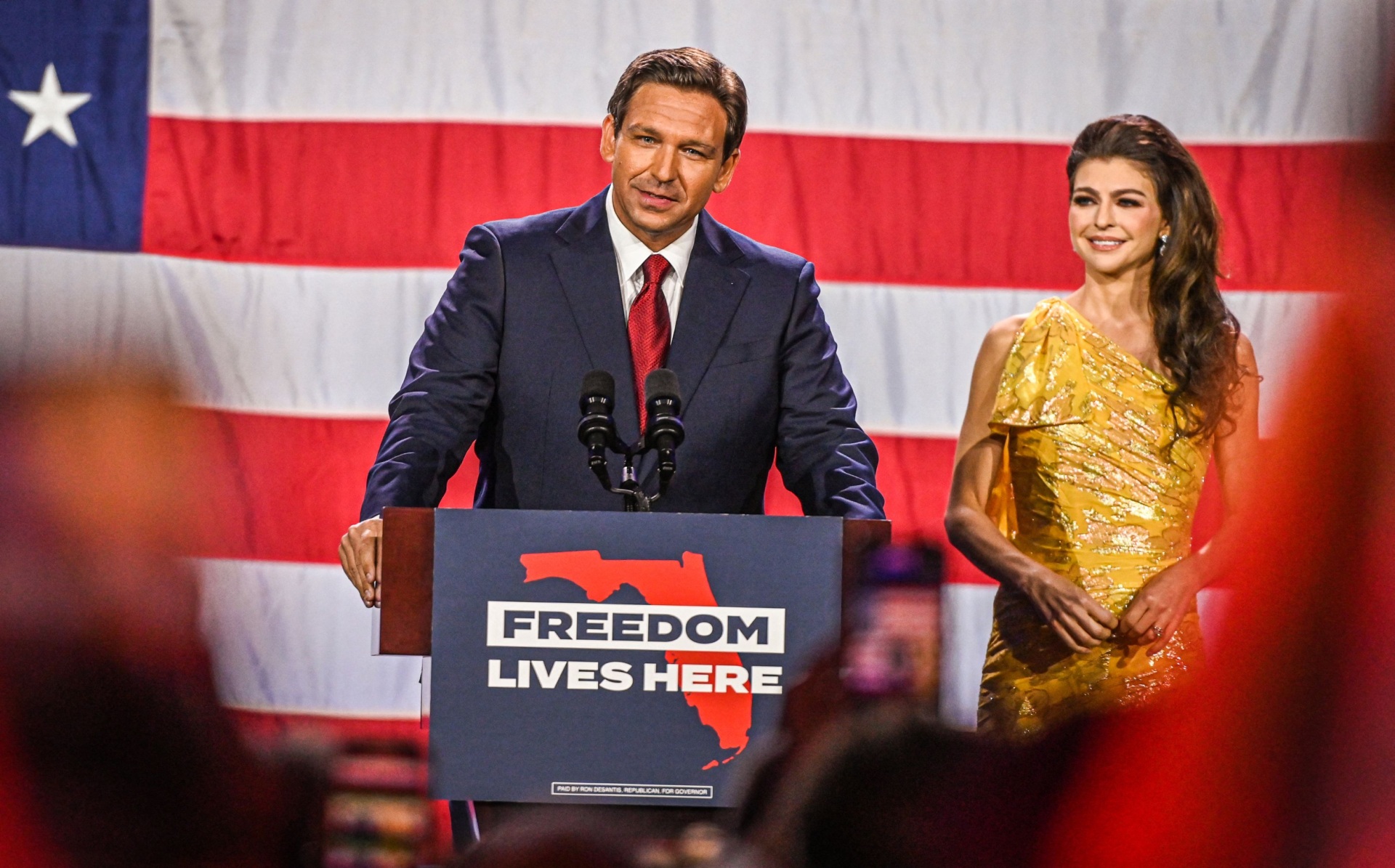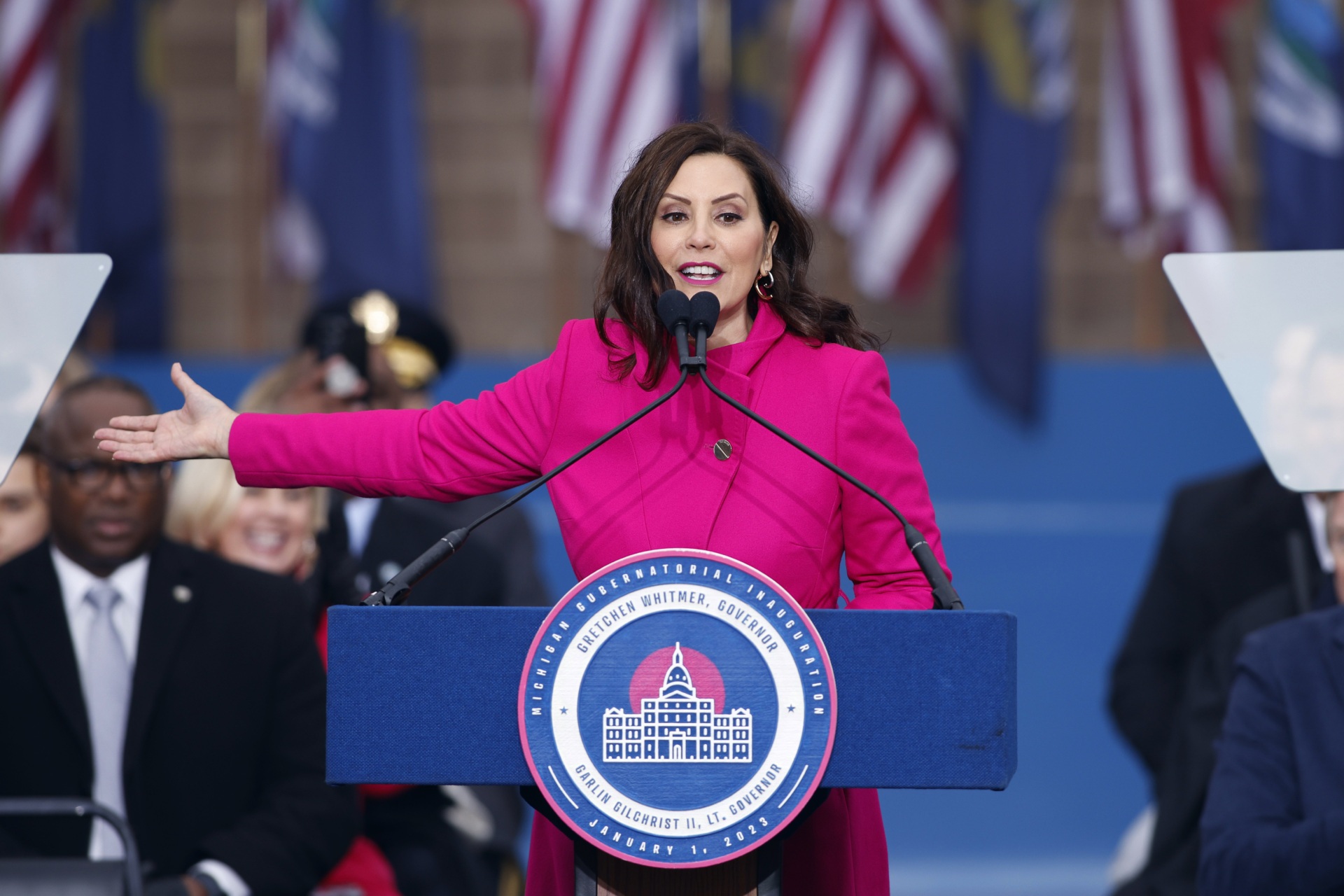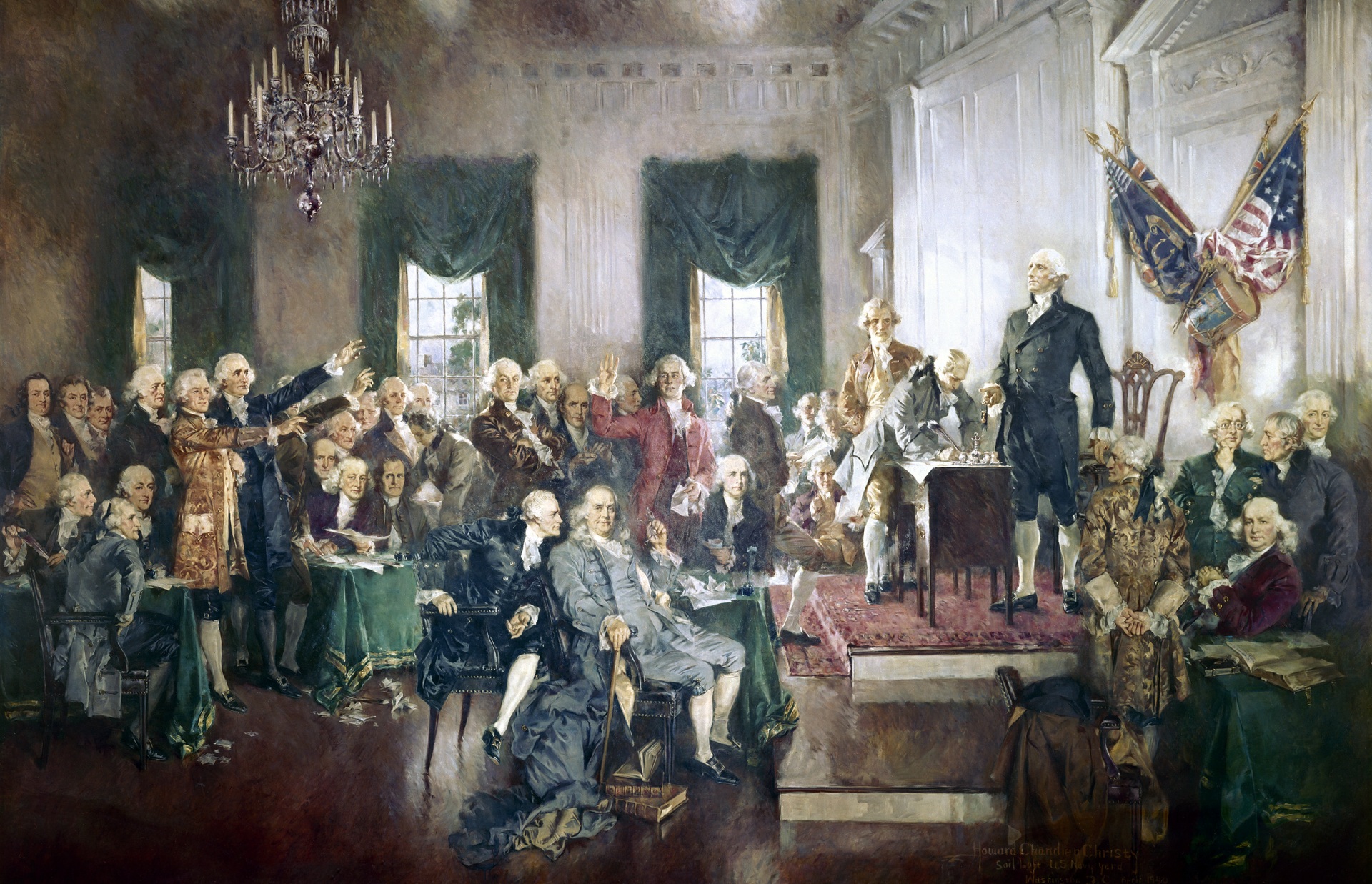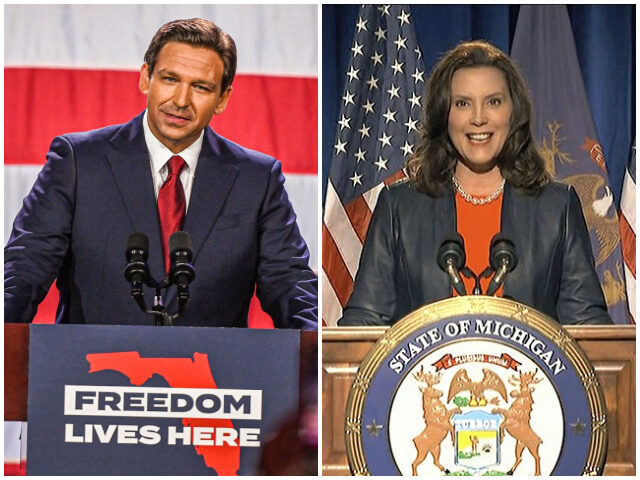Sunshine and Wolverine
Two news items, appearing on the same day, January 19, show that Florida is moving right, while Michigan is moving left. That divergence between two big states is all the more interesting because the Republican governor of Florida, Ron DeSantis, and the Democratic governor of Michigan, Gretchen Whitmer, are rising stars within their respective parties. So it’s possible that they will both one day be on a national presidential ticket—perhaps even running against each other.
Yet whatever happens to DeSantis and Whitmer, the issues being raised in their states—one solidly red, the other less solidly blue—tell us much about where the nation is headed. And where’s that? Back to an earlier and truer vision of the United States as a nation of states, respectful of each other, but also respectful of their differences.
We should recall that state sovereignty—the right of a state to decide for itself, even if it’s a bad decision—is at the heart of our Constitution. That sacred document, ratified in 1788, explicitly leaves most matters to the states; the doctrine is known as states’ rights. To be sure, the idea of state sovereignty had been on the wane for a long time, as the federal government sought to micromanage, even dictate, local decisions. But now, states’ rights are back.
The news item about Florida concerned the rejection the College Board’s proposed advanced placement high school course on African American studies, which Sunshine State authorities, having examined its woke and CRT-laden particulars, declared to be “inexplicably contrary to Florida law, adding that it “significantly lacks educational value.” As DeSantis likes to say, Florida is “where woke goes to die.” That’s Florida for you, and if the federal government doesn’t like it, too bad (which is not to say that there couldn’t be lawsuit). And if, say, Californians don’t like it, they can stay in California and be as woke as they wish—including moving forward on slavery reparations.

Republican gubernatorial candidate for Florida Ron DeSantis with his wife Casey DeSantis speaks during an election night watch party in Tampa, Florida, on November 8, 2022. (GIORGIO VIERA/AFP via Getty Images)
Florida was once seen as a swing state, and yet now, thanks in no small part to DeSantis, it’s strongly Republican. Florida voted for Donald Trump in 2020, and in 2022, DeSantis himself was re-elected by a thumping 19 points. There are no Democrats holding statewide office, and Republicans control the U.S. House delegation, 20:8. At the same time, the GOP boasts super-majorities in both chambers of the state legislature.
The news item about Michigan was a Washington Post story that heaped praise on Whitmer, who in 2022 was also re-elected in a landslide—albeit by a narrower margin than DeSantis, 10 points. As the Post puts it, Whitmer, now beginning her second term, has advanced “a barrage of culturally liberal legislation, including new LGBTQ protections.” In addition, Whitmer is pushing an abortion-guarantee bill that Republicans had previously blocked. And we can be sure that wokeness and CRT are doing fine in most Michigan schools.
The Post story also highlighted Michigan State Sen. Mallory McMorrow, a telegenic 36-year-old who is being built up by the Main Stream Media as a champion of progressivism—and hoped-for Democratic victories. “I hope that we do become the model,” McMorrow told the Post about her state, adding that Democrats everywhere should rally around the principle that “everybody is welcome” (translation: open borders, sanctuary cities, more drag queen story hours) and “we talk about our past in honest terms” (translation: lots of 1619 Project-type rewriting of history).
Michigan is slightly less solidly Democratic than Florida is Republican. The Wolverine State voted for Joe Biden in 2020, and it re-elected Whitmer in 2022, an election that also saw Democrats sweeping statewide offices and the state legislature. The Democrats control the U.S. House delegation only narrowly, seven to six, and yet no Republican has won a U.S. Senate seat there since 1994.

Michigan Gov. Gretchen Whitmer addresses the crowd during inauguration ceremonies, Sunday, Jan. 1, 2023, outside the state Capitol in Lansing, Mich. (AP Photo/Al Goldis)
So yes, the two states have very different histories—and, most likely, different destinies. For instance, in 1960, Michigan’s population entitled it to 18 Members of the House of Representatives. Yet now, after decades of shrinkage, the state accounts for just 13. In comparison, in 1960, Florida had eight Representatives. Today, it has 28.
Given these different pasts, no wonder the respective state leaders seem to see different futures: In her second inaugural address on January 1, Whitmer said, “Let’s tackle climate change head-on.” That’s probably not the best plan for the beleaguered U.S. auto industry, but as we know, Democrats have mostly written off the working class, seeing their future with the poor and the affluent.
By contrast, in his second inaugural address on January 3, DeSantis didn’t mention “climate change” at all, but he did use the word “free,” or “freedom,” 14 times. For her part, Whitmer used “freedom” mostly to invoke the liberal position on abortion and gay marriage. In Tallahassee, DeSantis emphasized that Florida is the fastest-growing state, and “number one in new business formations.” In Lansing, Whitmer barely mentioned growth and didn’t use the word “business” once.
Yet still, different as they are, both DeSantis and Whitmer are in charge of their states for the next four years. Indeed, both can expect to have a voice in national debates—and maybe more than that.
Indestructible States
The Founders knew that the states would be different. To them, that was a good idea, because central authority was never to be trusted, and so power should be distributed. As Patrick Henry declared, “Shew me that age and country where the rights and liberties of the people were placed on the sole chance of their rulers being good men, without a consequent loss of liberty.” That is, wise patriots shouldn’t put trust in the goodness of any government, especially a national government. Instead, they should rely on themselves to safeguard their liberties, creating legal checks and balances against the risk of tyranny—with one kind of check being the states.
Precisely because of his fear of a central power, Henry opposed the ratification of the Constitution after it was drafted at the Philadelphia convention in 1787. Mindful of such opposition, proponents of the Constitution were at pains to assure the public that the new document would not put too much muscle in a distant national government. As James Madison wrote in 1788, “The States will retain, under the proposed Constitution, a very extensive portion of active sovereignty.” That same year, Alexander Hamilton argued that Congress “has only general powers, and the civil and domestic concerns of the people are regulated by the laws of the several states.” There you have it: states’ rights.
Still, to make extra sure that the new United States did not unduly hamper liberty, the American people soon added the Ninth Amendment to the Constitution, which reads, in its entirety, “The enumeration in the Constitution, of certain rights, shall not be construed to deny or disparage others retained by the people.” In other words, the default mode is freedom. And they added, too, the Tenth Amendment, which reads in its entirety: “The powers not delegated to the United States by the Constitution, nor prohibited by it to the States, are reserved to the States respectively, or to the people.” Once again, the default mode is freedom, with the added proviso that the states would be an important legal barricade against national usurpation.

The Signing of the Constitution of the United States, with George Washington, Benjamin Franklin, and Thomas Jefferson at the Constitutional Convention of 1787; oil painting on canvas by Howard Chandler Christy, 1940.
Yet even so, the issue of restraining federal power continued to preoccupy the Founders. Steeped as they were in history, they knew that concentration was always inimical to freedom. In 1821, Thomas Jefferson wrote to Charles Hammond, declaring of centralized power, “I am opposed.” Jefferson added, “whenever all government, domestic and foreign, in little as in great things, shall be drawn to Washington as the center of all power, it will render powerless the checks provided of one government on another, and will become as venal and oppressive as the government from which we separated.” That is to say, the federal government could become as bad as the British government, against which Jefferson and the other patriots had rebelled.
Across American history, other leading figures vindicated a strong role for the states. In 1869, Supreme Court Chief Justice Salmon P. Chase wrote in a majority opinion, “The Constitution in all its provisions, looks to an indestructible Union, composed of indestructible states.” And in 1932, another Supreme Court Justice, Louis Brandeis, lauded the states as much-needed “laboratories of democracy.”
Happily, the Constitution, including its federalist, states’ rights component, has been “loose-jointed” enough to allow the states, individually and collectively, to respond to new challenges. Such flexibility is a big reason why this country has flourished these past 233 years.
Yet the Constitution has gotten “stiffer” in recent decades, as the federal bureaucracy and judiciary has fulfilled Jefferson’s nightmare, expressed in that 1821 letter: “Washington as the center of all power,” becoming “venal and oppressive.” So that’s why we should study our own history: so we can be reminded that the Founders would be horrified at the creep of centralization we’ve seen in recent decades. Careful study of original intent provides the intellectual antidote to big-government cheerleading.
Laboratories of Diversity
Diversity is more than just skin color. We aren’t just ethnically and culturally diverse, we are also ideologically and politically diverse. Indeed, we are so diverse, in so many ways, that the federal government cannot continue to function as it has for the past century or so. To put the point another way, one size does not fit all. Not for all 335 million of us, scattered across 50 states.
To get a gauge of just how diverse we are, in all senses of the word, we might consider Oregon. In 2020, the voters of the Beaver State enacted Measure 110, which decriminalized small amounts of hard drugs, including heroin. That seems pretty radical, and yet 58 percent of Oregonians voted for the measure. And if easing up heroin—and meth, cocaine, etc.—still doesn’t seem like such a good idea to you, thank the Constitution, because the law only applies to Oregon. You see, federalism and states’ right allow for compartmentalization, so a bad outcome in one state doesn’t have to spill over to another state. Of course, the people of Oregon don’t seem to think they made a mistake passing their drug bill: progressive Democrats are still in charge there. In 2022—drugs, crime, and Antifa notwithstanding—they retained the governorship, as well as all the other major state offices. So now, heroin and all, Oregon is serving as one of the 50 laboratories of chemistry. Oops, I mean diversity, or democracy.
We can see this diversification occurring on other issues. For instance, the Associated Press reports that since the Supreme Court’s Dobbs decision, overturning the infamous Roe v. Wade, the states have become a legal “patchwork”:
Since June, near-total bans on abortion have been implemented in Alabama, Arkansas, Idaho, Kentucky, Louisiana, Mississippi, Missouri, Oklahoma, South Dakota, Tennessee, Texas and West Virginia.
In the meantime, of course, other states have emphatically legalized abortion—including, quite possibly this year, Michigan.
There’s something happening here. What it is ain’t exactly clear: But it’s clear enough. The idea that one central authority can set the standard for the nation is out the window. That was the mistake the Supreme Court made in 1973 with Roe; the unelected majority sought to unilaterally legislate its own abortion policy, as opposed to doing what it should have done, which is to adjudicate laws made by 50 elected legislatures. By now we know that the 50 states are not ever going to agree on abortion, and so the federal government should play a minimal role, not a maximal role.
Diversity Becomes Duality
Okay, so the states are diverse. Each state has the Constitution-given power to chart its own course, and as red becomes redder and blue becomes bluer, they are growing more assertive in their charting.
Yet there’s an additional dynamic to consider: For all the diversity of the 50 states, there are still only two parties. For better or worse, our first-past-the-post electoral system helps cement the two-party duopoly. In other words, all our diversity is being channeled, as it were, into the two-party system. As a general rule, if you want to win in politics, you have to be either a Republican or a Democrat. (The two “independents” in the U.S. Senate, Angus King and Bernie Sanders, are, for all practical purposes, Dems.)
It may seem ironic that the 50 states’ diversity funnels into this duality. But we can observe that the two-party system has survived for the same reason that the Constitution has survived: loose-jointedness. That is, the two parties themselves are diverse. The ranks of Republican governors, for instance, includes DeSantis, but also the moderate-to-liberal Phil Scott, just re-elected to a fourth term as chief executive of Vermont. A party includes DeSantis and Scott obviously has no litmus test. And were the Republican Party to start imposing litmus tests, it would shrink.
Yet of course, no Republican sees Scott as a future national leader. Contrastingly, DeSantis already is a national leader for the GOP, just as Whitmer is a national leader for the Democrats. So what will happen next? Will they ever confront each other directly? Stay tuned.
Yet beyond whatever happens to those two governors, there’s the larger trend: The United States is still united, and yet it’s reuniting around a looser vision of state power, much closer to the Founders’ original intent on states’ rights. That’s a vision that allows more room for the states, and their people, to enjoy their own rights to life, liberty, and the pursuit of happiness. Or, in the case of oh so diverse Oregon, the pursuit of a fix.

COMMENTS
Please let us know if you're having issues with commenting.